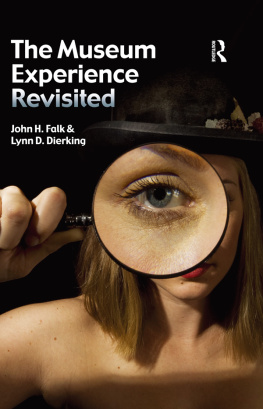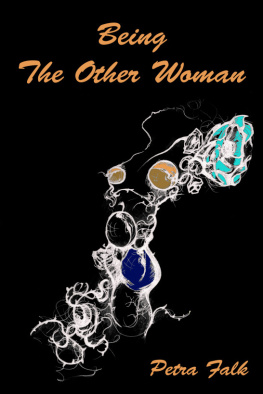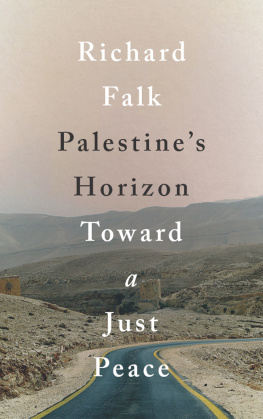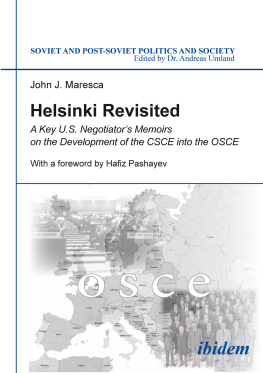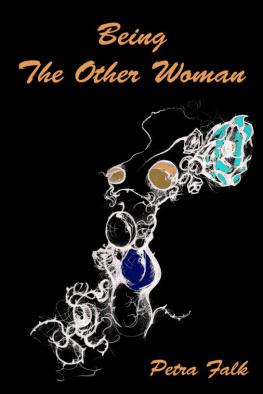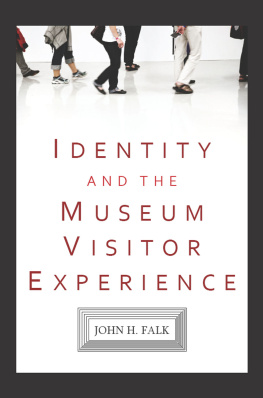First published 2013 by Left Coast Press, Inc.
Published 2016 by Routledge
2 Park Square, Milton Park, Abingdon, Oxon OX14 4RN
711 Third Avenue, New York, NY 10017, USA
Routledge is an imprint of the Taylor & Francis Group, an informa business
Copyright 2013 Taylor & Francis
All rights reserved. No part of this book may be reprinted or reproduced or utilised in any form or by any electronic, mechanical, or other means, now known or hereafter invented, including photocopying and recording, or in any information storage or retrieval system, without permission in writing from the publishers.
Notice:
Product or corporate names may be trademarks or registered trademarks, and are used only for identification and explanation without intent to infringe.
Library of Congress Cataloging-in-Publication Data
Falk, John H. (John Howard), 1948-
The museum experience revisited / John H. Falk and Lynn D. Dierking.
p. cm.
Includes bibliographical references and index.
ISBN 978-1-61132-044-2 (hardback : alk. paper)ISBN 978-1-61132-045-9
(pbk. : alk. paper)ISBN 978-1-61132-046-6 (institutional ebook)ISBN
978-1-61132-562-1 (consumer ebook)
1. MuseumsEducational aspects. I. Dierking, Lynn D. (Lynn Diane), 1956- II. Title.
AM7.F352 2012
069.15dc23
2012027276
ISBN 978-1-61132-045-9 paperback
ISBN 978-1-61132-044-2 hardback
The museum visitor is not an empty vessel, waiting to be filled with our wisdom. While this seems obvious, especially as I write this today, until I encountered that truism head-on in the first edition of The Museum Experience, I have to admit that I hadnt really tried to understand the visitors perspective in the many museum programs I created in the early years of my career. Before 1992, I had worked in two different museums (one art and one ethnographic), where I had developed exhibitions and programs for many different audiences, including the public, teachers, and students. I had partnered with talented designers, scholars, and curators and been a curator myself. I cared deeply about the content and quality of the museum experiences I was helping to craft.
But did I really think hard about, let alone investigate, what the visitor or prospective visitor already knew or cared to know? Had I considered the various personal, social, and cultural contexts that shaped visitor encounters with the museum, including pre- and post-visit experiences and interests? Passionate and well-meaning, I thought my earnestness, hard work, project research, and content knowledge were the key ingredients to success. The Museum Experience, therefore, made a big impression on me and helped guide my post-1992 museum practice. I suspect I was not alone.
Twenty years after its initial publication, in this new edition of The Museum Experience, authors John Falk and Lynn Dierking build on the insights of the initial volume and enrich the book with updates that reflect theirand otherssubsequent studies and research findings. During the past two decades, the museum field has paid increased attention to the nature, quality, and impact of museum experiences. Bolstered by The Museum Experience, such landmark reports as Excellence and Equity, published by the American Association of Museums (1992), and multidisciplinary research on the nature of learning, including learning throughout the lifetime and the power of learning in out-of-school settingsas well as a myriad of individual programmatic evaluations, many museums have rethought and revamped their programs and processes. Within institutions, of course, these changes occur within typically tight operating environments where the museums mission, programs, and costs need to be kept in balance. Being aware of relevant research, knowing more about potential communities and audiences, and having better ways to ascertain what works can enable a museum to deploy resources in service to mission more effectively and efficiently. Beyond the museum, there have been increased demands from outside stakeholders, including private and public funders, who require logic models, evaluation plans, and measures of audience impact before providing support. Evaluation has become more commonplace and nuanced. We have learned much about our visitors (and non-visitors). Yet we still have miles to go.
In the twelve chapters of this book, Falk and Dierking elaborate on their original contextual model of learning, bolstered by many studies conducted in the last two decades. This model focused on the personal, sociocultural, and physical contexts of the museum and its visitors. The importance of museum practitioners understanding visitors at the confluence of these contexts has not diminished; indeed, I venture that it has increased, although there are undoubtedly many museums who have yet to absorb, let alone adopt, this broader contextual framework.
Each of these contextsthe personal, sociocultural, and physicalhas been enriched by new thinking and research. For example, the personal context is elaborated by Falks work on identity-related motivations. Falk describes the various identity lenses that characterize personal museum going motivations, noting that these lenses are fluid and dynamic: individuals can and do use them interchangeably based on specific circumstances and motivations. Hence, museum visitors may see themselves as explorers, facilitators, professionals/hobbyists, experience seekers, rechargers, respectful pilgrims, and/or affinity seekers, and these various identities color and characterize their museum experiences.
The discussion of sociocultural context is enriched by the recognition of the broader learning ecosystem that exists in any community and the need for museums to understand and implement their role within these systems. What are the communitys learning needs and how can the unique affordances of the museum meet them? How can museums build on their collections of real things and their reputations as places of trust and expertise to make a difference? In this section, informed particularly by Dierkings extensive work with youth and families, Falk and Dierking emphasize the importance of museums exploring, articulating, and demonstrating their public value, as the right and necessary thing to do.
The authors treatment of the physical context includes exhibitions, galleries, and museum buildings (including the parking lots and other amenities that are often important parts of the visitor experience) and also underscores the need to consider the surround of exhibitions, including programs, and the increasing significance of the virtual. The final chapters explore the gestalt that reflects the confluence of these contexts and new research on what we have learned about the interplay between memory and learning. They feature two deep dives into evaluation case studies: Falks extensive work at the California Science Center and Dierking and McCreedys longitudinal studies on the impact of out-of-school STEM programs for girls. The volume ends with real-life examples of the twenty-first-century museum. Each chapter is capped (usefully) with summary points and suggestions for practitioners.




